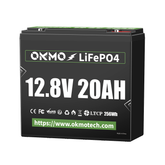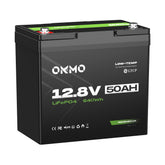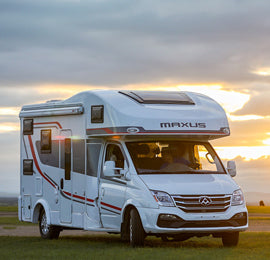How to Store Lithium Batteries Safely in the House ?

Lithium batteries have become indispensable in modern life, powering everything from smartphones and laptops to electric vehicles and home energy storage systems. However, improper storage of these batteries can pose serious risks, including fires, explosions, or toxic chemical leaks. This article will guide you through the safety standards for indoor lithium battery storage, compare the stability of lithium-ion (Li-ion) and LiFePO4 (Lithium Iron Phosphate) batteries, and recommend the OKMO LiFePO4 Battery as a safer, more reliable choice for home use.
Part 1: Safety Standards for Indoor Lithium Battery Storage
To minimize risks, follow these guidelines when storing lithium batteries at home:
1. Temperature Control
-
Ideal Range: Store batteries in a cool, dry place between 15°C to 25°C (59°F to 77°F).
-
Avoid Extremes: Temperatures above 60°C (140°F) can trigger thermal runaway (uncontrolled self-heating), while temperatures below 0°C (32°F) may reduce performance and cause irreversible damage.
2. Humidity Management
-
Keep humidity levels below 50% to prevent corrosion of battery terminals.
3. Avoid Physical Damage
-
Store batteries away from sharp objects or heavy items that could puncture or crush them.
4. Charge State
-
Partial Charge: Store lithium batteries at 30–50% state of charge (SOC). Full charge or deep discharge accelerates degradation.
-
Recharge Periodically: Check stored batteries every 3–6 months and recharge to 30–50% if needed.
5. Isolation and Ventilation
-
Place batteries in non-conductive containers (e.g., plastic bins) away from flammable materials.
-
Ensure the storage area is well-ventilated to disperse any gases released during failure.
6. Fire Safety Precautions
-
Install a smoke detector nearby.
-
Keep a Class D fire extinguisher (designed for metal fires) accessible.

Part 2: Stability Comparison: Li-ion vs. LiFePO4 Batteries
While all lithium batteries require careful handling, LiFePO4 batteries are inherently safer and more stable than traditional Li-ion batteries (e.g., NMC or LCO). Here’s why:
1. Thermal Stability
-
Li-ion Batteries:
-
Use flammable liquid electrolytes (e.g., lithium cobalt oxide).
-
Prone to thermal runaway at 150–200°C (302–392°F), leading to fires or explosions.
-
-
LiFePO4 Batteries:
-
Use stable phosphate-based cathodes and non-flammable electrolytes.
-
Withstand temperatures up to 270°C (518°F) without thermal runaway.
-
2. Chemical Stability
-
Li-ion Batteries:
-
Oxygen released during decomposition fuels fires.
-
Sensitive to overcharging, which can cause swelling or rupture.
-
-
LiFePO4 Batteries:
-
Chemically inert structure resists overcharging and over-discharging.
-
No oxygen release, significantly reducing fire risks.
-
3. Cycle Life and Degradation
-
Li-ion Batteries:
-
Typically last 500–1,000 cycles before capacity drops to 80%.
-
Degrade faster under high temperatures or frequent deep discharges.
-
-
LiFePO4 Batteries:
-
Deliver 3,000–5,000 cycles (even up to 15,000 cycles in premium models).
-
Maintain stable performance across wider temperature ranges.
-


Part 3: Why Choose the OKMO LiFePO4 Battery for Home Use?
When safety and reliability are priorities, the OKMO LiFePO4 Battery stands out as an ideal choice for indoor energy storage. Here’s how it addresses key safety concerns:
1. Built-In Safety Technologies
-
Advanced BMS (Battery Management System):
-
Monitors voltage, temperature, and current in real time.
-
Automatically disconnects the battery during overcharge, over-discharge, or short circuits.
-
-
LTCP (Low-Temperature Charging Protection):
-
Prevents charging below 0°C (32°F) to avoid lithium plating and internal damage.
-
2. Superior Stability
-
Fire-Resistant Design:
-
LiFePO4 chemistry eliminates risks of thermal runaway.
-
Flame-retardant casing adds an extra layer of protection.
-
-
Wide Temperature Tolerance:
-
Operates safely from -20°C to 60°C (-4°F to 140°F).
-
3. Certifications and Compliance
-
Meets UL 1973, UN38.3, and RoHS standards, ensuring safety and environmental compliance.
4. Home Energy Applications
-
Solar Storage: Stores solar energy efficiently with minimal degradation.
-
Backup Power: Provides reliable power during outages without fire hazards.

Conclusion
Storing lithium batteries safely at home requires attention to temperature, charge levels, and physical protection. While traditional Li-ion batteries pose significant risks due to their volatile chemistry, LiFePO4 batteries like the OKMO 12V 200Ah LiFePO4 Battery offer unparalleled stability, longevity, and safety. With its advanced BMS, LTCP technology, and robust certifications, the OKMO battery is engineered to deliver peace of mind for residential energy needs.
Upgrade to OKMO LiFePO4 – where safety meets sustainability.
By choosing LiFePO4, you’re not just storing energy; you’re safeguarding your home.








